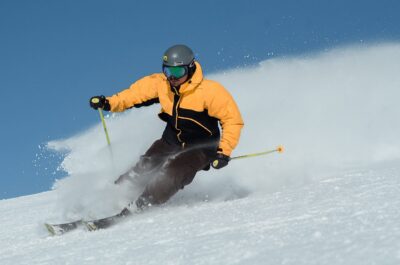 When winter is upon us and come with it the dark mornings and nights, it’s not uncommon for us to start pining for a much needed holiday. If you’re an office worker, you might be spending your long work days staring out the window by your desk and daydreaming of where you might like to head off to.
When winter is upon us and come with it the dark mornings and nights, it’s not uncommon for us to start pining for a much needed holiday. If you’re an office worker, you might be spending your long work days staring out the window by your desk and daydreaming of where you might like to head off to.
Whilst many of us seek out the sunshine and beach in the summer, people often look for adventure over winter and think about hitting the slopes – a big change from sitting at your workstation in front of your computer monitor, keyboard and phone for up to 60 hours a week.
Spending up to eight hours a day on the slopes is many people’s idea of heaven, but it’s important to think about how to prevent yourself from being stopped in your tracks by potential injuries, particularly if you’re a first timer. Skiing and snowboarding demand technique, muscle strength and flexibility to get down the slopes safely.
We can all be guilty of not finding the time to exercise because of demanding, stressful jobs and being tied to our desks. So what can you do to prevent putting yourself at risk from these aches and pains before donning your skis or snowboard? Our friends at Physiomove London have come up with their top tips on how to get fit for the slopes…
1. Work on your cardiovascular fitness
To prepare for the physical nature of skiing and snowboarding, look to short, high-intensity exercises. For example, you could sprint up a hill for two minutes then work less hard for a minute. Plyometric training, such as jump lunges and burpees, will not only help with cardiovascular fitness but will help you to adapt to rapid changes in speed similar to what you will experience in the mountains.
You can incorporate many different exercises into your regime, as long as you follow the work/rest pattern. Aim to do interval training three to four times a week for 20 to 30 minutes each time .
This is made all the more important if you have an office based job – even if you simply make more of an effort to take regular breaks, move around more and stretch during your work day.
2. Improve muscle strength
You should look to exercises that will improve your muscle strength, power and endurance, which will improve your flexibility, posture, reduce aches and pains and lower your risk of injury. You should focus on your core, quadriceps, hamstrings and glutes and exercises could include plank holds, forward and reverse lunges, squats and deadlifts. You can also run down a hill for eccentric quadriceps strength.
Your core, which includes abdominals and back muscles, is important for skiing and snowboarding because it helps with balance and protecting the spine so working on improving core strength is key.
3. Train for correct alignment for skiing
To keep your energy reserved you need to be efficient in your technique. You should practice the skiing position daily in the run up to your holiday, allowing you to work naturally when you get to the slopes and help ensure you put yourself at minimal risk of injury or joint pain. Bad posture from incorrect ergonomics of workstations can lead to bad habits and musculoskeletal problems, such as back, neck and shoulder pain, so getting the body used to the posture needed for skiing and snowboarding is vital.
4. Balance and agility
Balance is a key skill for skiing and snowboarding to keep falls to a minimum. There are a number of exercises you can do to improve your balance – and a Bosu ball can quickly become your new best friend.
With the ball round side up, stand on the ball with one foot, keeping your knee soft. Hold it for a few seconds and repeat the exercise 10 to 15 times. To make this harder, you can move your other foot out to the side. Work towards increasing your holding and/or repetition time.
Other effective balance exercises include single leg dead-lifts and speed skaters.
Agility is also important on the slopes because it helps you to move and change direction quickly. Exercises to improve agility can include single-leg forward hops, side step with toe touches, sprints up stairs and forward and backward jumps.
5. Keep flexible
Even a professional skier and snowboarder falls so it is crucial to warm up before hitting the slopes. Spending endless hours working front of a computer sitting down, hip-flexors are often tight and its definitely an area you need to loosen up and stretch if you spend long hours sitting down in an office.
Yoga and Pilates can also be extremely beneficial. Yoga is a great alongside strength exercises as helps to improve flexibility and balance. Pilates focuses on core strength, posture and to correct muscle imbalance, which are all vital on the slopes.
6. Eat well
It’s easy to get caught up in all the delicious food and alcohol which is right in front of us in most of the popular ski resorts. Although we all need a well deserved treat, you need to remember the importance of a healthy and balanced diet when you are burning so many calories each day. Alcohol also dehydrates you and if you’re sweating from the physical exertion, you need to keep your fluid intake up. Taking snacks and water up the slopes will help you to keep your energy going, as well as prevent you from dehydrating .
Following these hints and tips should set you well on your way to a pain and injury free winter sports holiday, allowing you to make the most of your break with your family or friends.
However, we recommend that you consult your doctor or physiotherapist before taking up any new exercise or fitness programme to ensure it is being followed correctly. If you would like to have a ski assessment before hitting the slopes to help reduce the risk of injuries, the specialists at Physiomove London offer tailored evaluations to suit your needs.







